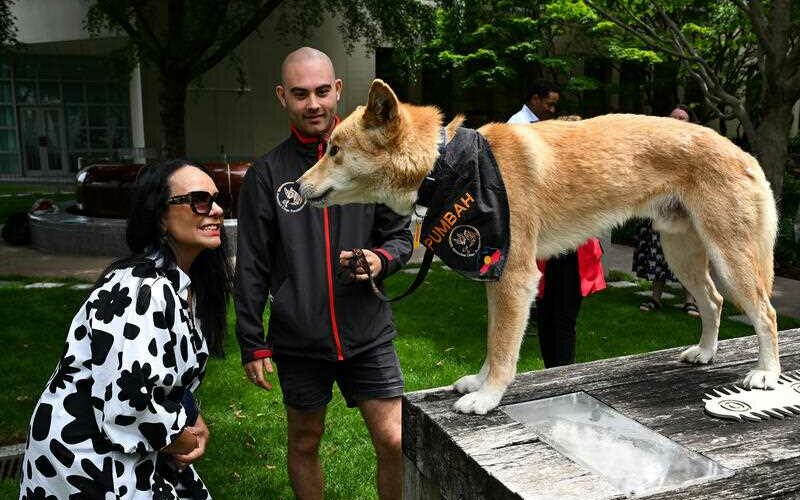Advocates for dingo protection are ramping up pressure on governments to stop lethal management programs. On the other side of the ring are the livestock industry, government agriculture departments and various organisations they fund. Zacharias Szumer investigates.
A unique moment in the annals of political lobbying was seen last Thursday as federal politicians – from Labor MPs Linda Burney and Ged Kearney to Greens’ Senator Dorinda Cox – were seen schmoozing with …. a dingo.
The dingo in question had been brought to Canberra by the Australian Dingo Foundation, to campaign against lethal dingo control.
As a predator species known to target sheep and calves, dingoes have long faced the wrath of the livestock industry and state agriculture departments.
In Victoria, where the foundation is based, the state government received reports that wild dogs had killed or maimed 1,249 livestock – out of herd numbers of around 15 million sheep and 3.6 million cows – in 2021-2022.
To manage this problem, the state employs 18 full-time ‘wild dog controllers’, implements various trapping and poison baiting programs, and offers a $120 bounty for the scalp of any wild dog.
A dingo took my baby. Or was it a wild dog?
As you may have noticed, control programs generally use the coverall term ‘wild dog’, which refers to any dog living in the wild, including feral dogs, dingoes and hybrids.
In August, 25 researchers wrote to the Victorian government arguing that “the characterisation of dingo backcrosses as ‘wild dogs’ is not evidence-based.”
They cited recent research, which found that only a small proportion of wild dingoes had dog ancestry. The research argued that crude methods of DNA analysis used in the past had significantly overestimated the amount of crossbreeding between dingoes and domesticated dogs.
![All-colours-can-be-dingoes.-Image-UNSW[1]](https://michaelwest.com.au/wp-content/uploads/2023/11/All-colours-can-be-dingoes.-Image-UNSW1.jpg)
Dingoes come in all colours. Image UNSW.
Cairns, a conservation geneticist, receives funding from the Australian Dingo Foundation and other advocacy groups but MWM is unaware of any existing challenges to her research findings.
She has, however, had disagreements with representatives of the National Wild Dog Action Plan (NWDAP), which describes itself as “Australia’s blueprint strategy for wild dog management that guides state, regional and local plans”.
In a letter to Victorian government ministers, NWDAP coordinator Greg Mifsud argued that the higher rates of purity found by Cairns were a result of baiting and trapping buffer zones, rather than a refinement of testing methods.
Mifsud, who is a qualified ecologist, told MWM he had since acknowledged the misinterpretation and clarified his statement to the ministers.
The livestock industry has skin (and cash) in the game
Like state governments, the NWDAP considers dingoes to be a sub-category of wild dogs but also acknowledges “the environmental and cultural significance of the dingo” and “its conservation status and legal protection” in some states and territories.
The NWDAP makes no bones about being a “livestock-industry driven initiative” and lists various farming organisations and livestock industry groups as its financial supporters, alongside state and commonwealth governments and departments.
The plan itself is largely funded by government money, although the position of the coordinator itself is entirely funded by the livestock industry, with significant in-kind support from various state government departments.
“I don’t hide that fact,” Mifsud said about the plan being industry-driven.
“They (farmers) have the most to lose by having poor wild dog management,” he said, adding that the plan “relies on input from all relevant land managers, both public and private and the community.”
As detailed in this 2022 report, Mifsud has on “numerous occasions … developed briefing notes or written directly to ministers to put forward evidence that supports ongoing wild dog management” and argued against those who would seek to “limit or prevent the control (lethal or otherwise) of wild dogs and dingoes”.
Mifsud told MWM that government departments saw him as “an independent resource that can help them deliver their programs more effectively. I certainly don’t pull their strings.”
Federal bureaucrats have praised the NWDAP for showing “how effective it can be when governments and industry work closely together to achieve valuable outcomes for the Australian agriculture sector and communities.”
A conflict of interest? It depends
“Dingoes are really complicated animals. They’re not easy to live with,” says conservation biologist Mike Letnic.
“Frankly, we probably do need areas where we don’t have them, and we also need areas where they are. And I think that the balance needs to shift a little bit to having more areas where we can have dingoes.”
MWM asked Letnic whether livestock industry funding constituted a conflict of interest.
That “depended on the purpose of the funding”, Letnic said.
If the aim of the funding is to develop better ways to kill dingoes there is no conflict of interest. If the funding is to assess the impacts of baiting on biodiversity it is another matter.
The NWDAP weighs in on both questions, but often cites research that isn’t funded by industry.
“There certainly are tensions when it comes to wild dog and dingo management and meeting the balance between the needs of livestock protection and biodiversity, but I believe our evidence-based approach meets both those objectives,” Mifsud told MWM.
Is the livestock industry tail-wagging the (wild) dog?
The NWDAP coordinator operates under the aegis of the Centre for Invasive Species Solutions (CISS), a research and advocacy organisation that works on a wide range of invasive species, such as deer, pigs, cats, carp and rabbits.
Although the CISS receives some funding from livestock industry bodies, the vast majority of its funding – almost $23 million in the 2021-2022 financial year – comes from federal, state and territory government departments.
Industry investment in the centre has been “modest”, equating to around 8 per cent per annum over the last five years, CISS Chief Executive Andreas Glanznig told MWM.
Glanznig strongly rejected any assertions that the centre had a bias towards industry, nor that it engaged in any form of political lobbying, and said CISS’ strategy was set by the centre’s independent board, not industry funders.
According to 2022 Australian Charities and Not-for-profits Commission filings, there were only two members of the centre’s six-person board with a livestock industry connection.
One previously served as chief executive of the Cattle Council of Australia and managing director of Meat and Livestock Australia, as part of a “thirty-year career in administration and policy development of the Australian beef, sheep meat and goat industries.”
Another, whose professional experience is in law, is a former director of Australian Country Choice Ltd, “Australia’s largest vertically integrated beef supply chain”. He also operates his own small cattle farm.
Those two members have since left the board and, according to the CISS, no current directors have a livestock industry connection.
Should dingoes be managed as an invasive species?
“A lot of things that the CISS does are good,” Cairns told MWM.
“They’ve been leading the way in tackling invasive carp, rabbits and pigs. But dingoes are a native animal, so they just shouldn’t be under the purview of the centre at all.”
It’s not clear whether the CISS or the NWDAP considers dingoes to be native.
“Within an asset-based management framework, they are considered a vertebrate pest in contexts where they threaten assets,” Glanznig told MWM, saying the centre was following the lead of governments in treating dingoes as a subcategory of ‘wild dog’.
For its part, the NWDAP has put out media releases such as “Is the dingo a true-blue native Australian species? Taxonomists say no”. Its 2020-2030 plan makes no reference to dingoes as possibly being a native species, except in reference to legislation under which they are classified as such.
Letnic said the CISS’ and NWDAP’s work on controlling dingoes wasn’t “about protecting ecosystems, it’s about protecting agriculture”.
It’s fine to protect agriculture, but it’s not fine to dress it up as something else.
Both the CISS and NWDAP often highlight the impact of wild dogs on native species, arguing that the management of wild dogs can have broader ecological benefits.
The NWDAP’s homepage, for instance, cites independent research that found dingoes were “by far the most significant threat” to koalas in one part of south-east Queensland.
Letnic has previously conducted research that found dingoes can help regulate numbers of feral cats and foxes, which both prey on native animals. He says researchers affiliated with the CISS and state agriculture departments have consistently argued against his findings.
The NWDAP says the “potential ecological benefits of dingoes remain speculative” and cites recent research that found a “demonstrable absence of evidence and evidence of absence” for such ecological benefits.
First Nations and the dingo
In September, more than 20 First Nations groups signed the National First Nations’ Dingo Declaration, which called for an immediate stop to lethal control.
“The dingo is a cultural icon representing a vital connection to Country whose significance cannot be put into words,” the declaration reads.
MWM asked the CISS and the NWDAP if there was any tension between lethal dingo management and respect for First Nations groups.
“The centre is respectful of First Nation peoples,” Glanznig said.
Mifsud told MWM that the declaration was signed by groups with a particularly strong connection to the dingo, which wasn’t necessarily shared by all First Nations groups.
“Some communities do not have the same connection with the dingo, and as such will manage them where they cause impacts on their livestock or where they have a greater connection or place a higher value on other native animals,” he said, adding that he had previously worked with Traditional Owners seeking assistance to manage dingoes on their pastoral cattle stations.
In other places, the NWDAP has argued against dingo plans supported by Indigenous groups.
In 2021, a long-term plan formulated by Parks Victoria and three Traditional Owner groups proposed the reintroduction of dingoes to the Grampians National Park in Western Victoria.
NWDAP members developed a submission arguing the plan was based on faulty ecological arguments.
The NWDAP also helped distribute a petition written by local sheep farmers who opposed the reintroduction plan, which was ultimately cancelled.
New documents: EPA and Forestry Corporation at loggerheads over forests, koala protection
Zacharias Szumer is a freelance writer from Melbourne. In addition to Michael West Media, he has written for The Monthly, Overland, Jacobin, The Quietus, The South China Morning Post and other outlets.
He was also responsible for our War Power Reforms series.


